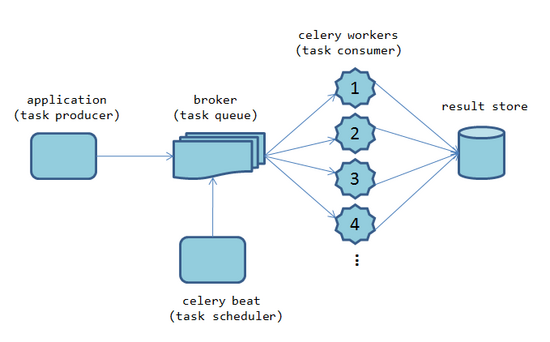所有演示均基于Django2.0
celery是一个基于python开发的简单、灵活且可靠的分布式任务队列框架,支持使用任务队列的方式在分布式的机器/进程/线程上执行任务调度。采用典型的生产者-消费者模型,主要由三部分组成:
- 消息队列broker:broker实际上就是一个MQ队列服务,可以使用redis、rabbitmq等作为broker
- 处理任务的消费者workers:broker通知worker队列中有任务,worker去队列中取出任务执行,每一个worker就是一个进程
- 存储结果的backend:执行结果存储在backend,默认也会存储在broker使用的MQ队列服务中,也可以单独配置用何种服务做backend

我的异步使用场景为项目上线:前端web上有个上线按钮,点击按钮后发请求给后端,后端执行上线过程要5分钟,后端在接收到请求后把任务放入队列异步执行,同时马上返回给前端一个任务执行中的结果。若果没有异步执行会怎么样呢?同步的情况就是执行过程中前端一直在等后端返回结果,页面转呀转的就转超时了。
异步任务配置
1.安装rabbitmq,这里我们使用rabbitmq作为broker,安装完成后默认启动了,也不需要其他任何配置
|
1
|
# apt-get install rabbitmq-server |
2.安装celery
|
1
|
# pip3 install celery |
3.celery用在django项目中,django项目目录结构(简化)如下
|
1
2
3
4
5
6
7
8
9
10
11
12
13
14
15
16
17
18
|
website/|-- deploy| |-- admin.py| |-- apps.py| |-- __init__.py| |-- models.py| |-- tasks.py| |-- tests.py| |-- urls.py| `-- views.py|-- manage.py|-- README`-- website |-- celery.py |-- __init__.py |-- settings.py |-- urls.py `-- wsgi.py |
4.创建 website/celery.py 主文件
|
1
2
3
4
5
6
7
8
9
10
11
12
13
14
15
16
17
18
19
20
21
22
23
24
|
from __future__ import absolute_import, unicode_literalsimport osfrom celery import Celery, platforms# set the default Django settings module for the 'celery' program.os.environ.setdefault('DJANGO_SETTINGS_MODULE', 'website.settings')app = Celery('website')# Using a string here means the worker don't have to serialize# the configuration object to child processes.# - namespace='CELERY' means all celery-related configuration keys# should have a `CELERY_` prefix.app.config_from_object('django.conf:settings', namespace='CELERY')# Load task modules from all registered Django app configs.app.autodiscover_tasks()# 允许root 用户运行celeryplatforms.C_FORCE_ROOT = True@app.task(bind=True)def debug_task(self): print('Request: {0!r}'.format(self.request)) |
5.在 website/__init__.py 文件中增加如下内容,确保django启动的时候这个app能够被加载到
|
1
2
3
4
5
6
7
|
from __future__ import absolute_import# This will make sure the app is always imported when# Django starts so that shared_task will use this app.from .celery import app as celery_app__all__ = ['celery_app'] |
6.各应用创建tasks.py文件,这里为 deploy/tasks.py
|
1
2
3
4
5
6
|
from __future__ import absolute_importfrom celery import shared_task@shared_taskdef add(x, y): return x + y |
注意tasks.py必须建在各app的根目录下,且只能叫tasks.py,不能随意命名
7.views.py中引用使用这个tasks异步处理
|
1
2
3
4
|
from deploy.tasks import adddef post(request): result = add.delay(2, 3) |
|
1
2
3
|
result.ready()result.get(timeout=1)result.traceback |
8.启动celery
|
1
|
# celery -A website worker -l info |
9.这样在调用post这个方法时,里边的add就可以异步处理了
定时任务的使用场景就很普遍了,比如我需要定时发送报告给老板~
定时任务配置
1. website/celery.py 文件添加如下配置以支持定时任务crontab
|
1
2
3
4
5
6
7
8
9
10
11
12
13
14
15
|
from celery.schedules import crontabapp.conf.update( CELERYBEAT_SCHEDULE = { 'sum-task': { 'task': 'deploy.tasks.add', 'schedule': timedelta(seconds=20), 'args': (5, 6) } 'send-report': { 'task': 'deploy.tasks.report', 'schedule': crontab(hour=4, minute=30, day_of_week=1), } }) |
定义了两个task:
- 名字为'sum-task'的task,每20秒执行一次add函数,并传了两个参数5和6
- 名字为'send-report'的task,每周一早上4:30执行report函数
timedelta是datetime中的一个对象,需要 from datetime import timedelta 引入,有如下几个参数
- days
- seconds
- microseconds
- milliseconds
- minutes
- hours
crontab的参数有:
month_of_year
day_of_month
day_of_week
hour
minute
2. deploy/tasks.py 文件添加report方法:
|
1
2
3
|
@shared_taskdef report(): return 5 |
3.启动celery beat,celery启动了一个beat进程一直在不断的判断是否有任务需要执行
|
1
|
# celery -A website beat -l info |
Tips
1.如果你同时使用了异步任务和计划任务,有一种更简单的启动方式 celery -A website worker -b -l info ,可同时启动worker和beat
2.如果使用的不是rabbitmq做队列那么需要在主配置文件中 website/celery.py 配置broker和backend,如下:
|
1
2
3
4
|
# redis做MQ配置app = Celery('website', backend='redis', broker='redis://localhost')# rabbitmq做MQ配置app = Celery('website', backend='amqp', broker='amqp://admin:admin@localhost') |
3.celery不能用root用户启动的话需要在主配置文件中添加 platforms.C_FORCE_ROOT = True
4.celery在长时间运行后可能出现内存泄漏,需要添加配置 CELERYD_MAX_TASKS_PER_CHILD = 10 ,表示每个worker执行了多少个任务就死掉
以上就是本文的全部内容,希望对大家的学习有所帮助,也希望大家多多支持服务器之家。
原文链接:http://www.cnblogs.com/37Y37/p/9310874.html










